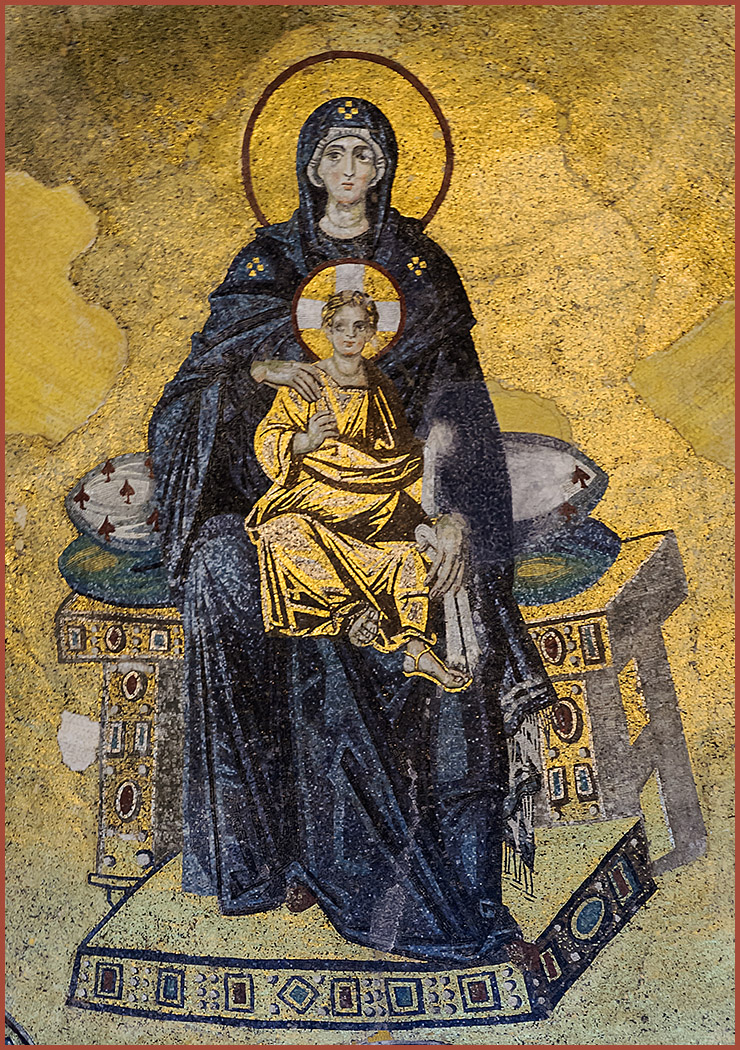 After the end of iconoclasm icons were allowed back into Hagia Sophia. At first they were placed on the walls at eye level so people could venerate them. These icons were in lots of different sizes from small to over life-sized. The aisles of the church were lined with shrines with icons and candle stands in front of them. The circuit of Hagia Sophia - this circle of images covered in silver, gold and gemstones - was one of the greatest masses of treasures in the world at the time. There was a period of time before mosaic images were put on the walls. One reason was their was hesitation that iconoclasm might return and slao the scale of this monumental image of the Theotokos had not been attempted for a very long time. There must have been a considerable period to planning that went into creating it. This image of Mary with the Christ Child on her lap must have been based on an illustration in a book or an existing icon - both small prototypes. The artists must have used some system to make the drawing in the apse, it is generally believed that they used circles to establish the proportions and then did a drawing followed by full-scale fresco that became the pattern for the mosaicists. The mosaic would have been put up using a wood scaffold - just like the one you see below. The Theotokos is youthful and very beautiful. She always wears one or two of three colors - imperial purple, dark violet and royal blue. Mary is always shown wearing a dress and a mantle called a maphorion. One of the chief relics if the city was the virgin's maphorion, which was kept in the Soros at the Church of the Blachernae. In times of great trouble or when enemies were at the gates of the city the maphorion was carried in procession around the walls.
After the end of iconoclasm icons were allowed back into Hagia Sophia. At first they were placed on the walls at eye level so people could venerate them. These icons were in lots of different sizes from small to over life-sized. The aisles of the church were lined with shrines with icons and candle stands in front of them. The circuit of Hagia Sophia - this circle of images covered in silver, gold and gemstones - was one of the greatest masses of treasures in the world at the time. There was a period of time before mosaic images were put on the walls. One reason was their was hesitation that iconoclasm might return and slao the scale of this monumental image of the Theotokos had not been attempted for a very long time. There must have been a considerable period to planning that went into creating it. This image of Mary with the Christ Child on her lap must have been based on an illustration in a book or an existing icon - both small prototypes. The artists must have used some system to make the drawing in the apse, it is generally believed that they used circles to establish the proportions and then did a drawing followed by full-scale fresco that became the pattern for the mosaicists. The mosaic would have been put up using a wood scaffold - just like the one you see below. The Theotokos is youthful and very beautiful. She always wears one or two of three colors - imperial purple, dark violet and royal blue. Mary is always shown wearing a dress and a mantle called a maphorion. One of the chief relics if the city was the virgin's maphorion, which was kept in the Soros at the Church of the Blachernae. In times of great trouble or when enemies were at the gates of the city the maphorion was carried in procession around the walls.
The image was lit by silver candelabra with glass inserts that set on the cornice at the base of the apse. They were lit by men who accessed them and kept them full of oil via a walkway. There was a weekly miracle of moving lights in the apse that astounded visitors to the church. A great silver candelabra in the shape of a cross miraculously elevated with lit candles, seemingly on its own power.
Christ wears a tunic and robe with sandals - all of gold - and has broad baby-like features. They are seated on a the golden, backless throne of the Byzantine Emperors. This mosaic was put up in the 9th century - almost 1200 years ago. It was intended to make a big, powerful statement about the victory of icons which had recently taken place. The mosaic would have been best seen from the sanctuary itself, where the clergy could appreciate it. It was put up by the clergy of Hagia Sophia, the best educated and most cultured group in the city of Constantinople. It is amazing that it has survived up until today when almost all of the mosaics of the church have been lost. One reason may have been the esteem that Muslims hold for Mary who they consider to be the mother of a prophet and a noble example of womanhood.
This mosaic was not covered up after the Muslim conquest and was visible for almost 300 years after 1453. Millions of Muslims prayed under the mosaic for generations after the conversion of Hagia Sophia into a mosque. This is true of all of the mosaics in the apse. It was not until around 1750 when they were covered over with plaster and paint. Why did it happen then, what had changed?
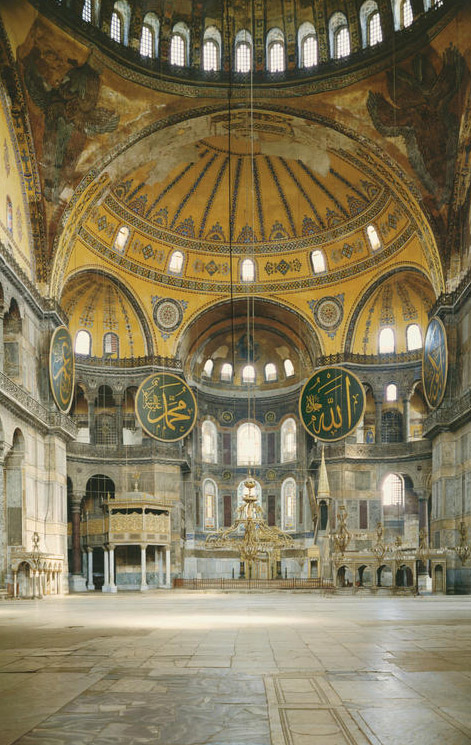 In the 1750's Ottoman power was under threat and the survival of the empire was under threat from both the Catholic Hapsburgs and the Orthodox Romanovs. In the face of this threat the Ottoman state had two options - to reorganize the military, liberalize the system and promote diversity among the many nationalities and religions that made up its population - or turn more authoritarian and enforce a more-Muslim identity on everyone. The Ottoman state lost its faith in the idea of a multi-national gathering of peoples under the Ottoman dynasty. The Ottomans were now facing a deadly line of Christian armies that were moving south. It was a religious war - a war between Islam and Christianity - that had reversed itself. Russia and Austria were on the rise and the Ottomans were on the defensive. They were entering a period of great uncertainty and loss of confidence. The most urgent task that faced them was the reorganization of army. If the army could not stop the Christian armies they were finished. Next they turned their attention to militarizing Islam within the empire. They hoped that the old Ghazi spirit of Muslim warriors who would fight the Christians with the religious fervor of the 1300s and 1400s.
In the 1750's Ottoman power was under threat and the survival of the empire was under threat from both the Catholic Hapsburgs and the Orthodox Romanovs. In the face of this threat the Ottoman state had two options - to reorganize the military, liberalize the system and promote diversity among the many nationalities and religions that made up its population - or turn more authoritarian and enforce a more-Muslim identity on everyone. The Ottoman state lost its faith in the idea of a multi-national gathering of peoples under the Ottoman dynasty. The Ottomans were now facing a deadly line of Christian armies that were moving south. It was a religious war - a war between Islam and Christianity - that had reversed itself. Russia and Austria were on the rise and the Ottomans were on the defensive. They were entering a period of great uncertainty and loss of confidence. The most urgent task that faced them was the reorganization of army. If the army could not stop the Christian armies they were finished. Next they turned their attention to militarizing Islam within the empire. They hoped that the old Ghazi spirit of Muslim warriors who would fight the Christians with the religious fervor of the 1300s and 1400s.
Another factor was the dislocation of hundreds of thousands of Muslims from areas retaken by the Christian armies, many of these people became refugees in Istanbul, a visible symbol of the danger the Islamic Sultanate was under. Nothing like this had ever been seen before. The Muslim charitable organizations that took charge of the refugees added to demands for religious symbols of Christianity in Istanbul be suppressed. Taking revenge on the mosaics of Hagia Sophia was a highly visual symbol for Muslims.
Adding to the uncertainty and unease, Istanbul had experienced a series of serious earthquakes in this period. Two in 1752 and another in 1754 were followed by a huge one (lasting two minutes) on the 11th of May, 1766 that was followed by eight months of aftershocks. An enormous amount of damage was done in and around the city.
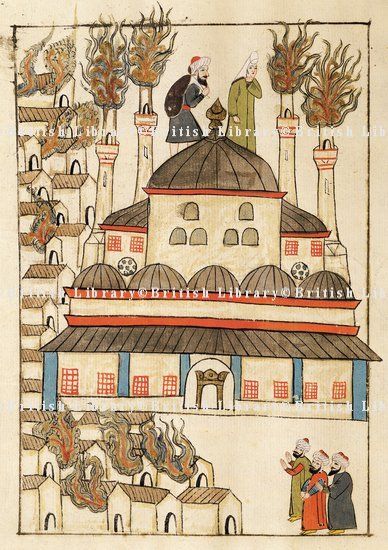 And there were fires - there were more 100 great fires in the 1700's. Great fires in Constantinople are always a sign of over-population and unhealthy living conditions. In 1712 the area of the Great Palace burned. In 1729 there was a great fire that burned an eighth of the city, including the Byzantine palace, Tekfur Saray. Sometimes there were multiple fires in one year, in 1746 there where 4 big blazes, that burnt thousands of houses. It must have felt like the city was constantly burning. One can imagine the flames and the smoke being seen continuously all over the city. In 1756 a fire in the Cibali district damaged 70 Turkish baths, 580 mills and bakes shops, 10 inns, 200 mosques and small mosques, 1000 shops and 800 dwellings.
And there were fires - there were more 100 great fires in the 1700's. Great fires in Constantinople are always a sign of over-population and unhealthy living conditions. In 1712 the area of the Great Palace burned. In 1729 there was a great fire that burned an eighth of the city, including the Byzantine palace, Tekfur Saray. Sometimes there were multiple fires in one year, in 1746 there where 4 big blazes, that burnt thousands of houses. It must have felt like the city was constantly burning. One can imagine the flames and the smoke being seen continuously all over the city. In 1756 a fire in the Cibali district damaged 70 Turkish baths, 580 mills and bakes shops, 10 inns, 200 mosques and small mosques, 1000 shops and 800 dwellings.
The Ottoman state was under pressure by religious fundamentalism to toe the line on Islamic purity. In the mid 1700's the mosaics of Hagia Sophia were covered over. They could have scrapped the interior of Hagia Sophia and replastered it, but that was too expensive in a time when all funds had to go to provisioning the army. Plaster were necessary paint everywhere else. Thank God, because we would have lost all of these mosaics if that had happened.
Hagia Sophia was not the only Byzantine Church to be defaced at this time. All across Istanbul old Byzantine churches (20 converted churches still exist in Istanbul) - like the Pantokrator - were stripped and scraped or their mosaics, whitewashed and re-purified as mosques. In the case of the Pantokrator an English visitor in 1743, Richard Pococke, described the mosaics that were - like Hagia Sophia - still uncovered 300 years after the conquest, "the whole is adorned with the figures of the apostles and the history of our Savior in mosaic work and the subject of each compartment is described in Greek". Sometime after 1766 they were all gone.
If you make it to the bottom of the text below, which completely describes this mosaic in every detail and leaving out nothing regarding its history, you will be an expert on the subject. If you visit Hagia Sophia you will be able to volunteer yourself as a tour guide!
I would like to make a couple of comments on this mosaic. This is the one everybody sees when you first enter the church. The church is so vast that the Virgin and Child looks really small. This was the first big image they put on the walls of the church after the end of iconoclasm. It was a big deal for everybody in Constantinople. First they had to plan this project - figure out what the subject matter would be and where it would go. Then they had to find an artist to draw it and well as a team of people to execute it. Then they had to get the supplies, like the mosaic cubes. They put up a scaffold in the apse of the church and did the drawing. This is where the big mistake was made that had an effect on how the mosaic looks and the distortions in it. They did the drawing high up in the air in the apse and it looked perfect from there. But they should have taken the scaffold down and looked at how the drawing looked from were people would see it from the floor of the church. The curve of the semi-dome and the height were not taken into account. They started work and wouldn't have been able to see the mistake they made until it was too late and the mosaic was finished.
The other theory is that the mosaic was made precisely to be seen from the ambo and the position of the Imperial throne to the south of the ambo. Patriarch Photius described the mosaic in the apse just as it would have looked at the dedication from the ambo where he delivered his sermon. The Patriarch would stand in the central bay of the South Gallery during the Liturgy. He would bow to the people from here and they would bow back. The mosaic was also meant to be seen from the South Gallery expressly for the Patriarch. This theory believes all of the apparent distortions in the figure and its throne vanish when it is viewed from the proper spots. I have seen the pictures that have been taken from this position and angle and they could be right.
The other problem was they used some materials for the mosaic that changed color over time. A dark brown granite they used on the throne turned light gray and a blue they used also turned much lighter. The mosaic is such an amazing survivor that we can forgive it as a first time effort gone a bit wrong. I am the team that made the mosaic learned a big lesson from the mistakes here and checked they work more carefully in the future.
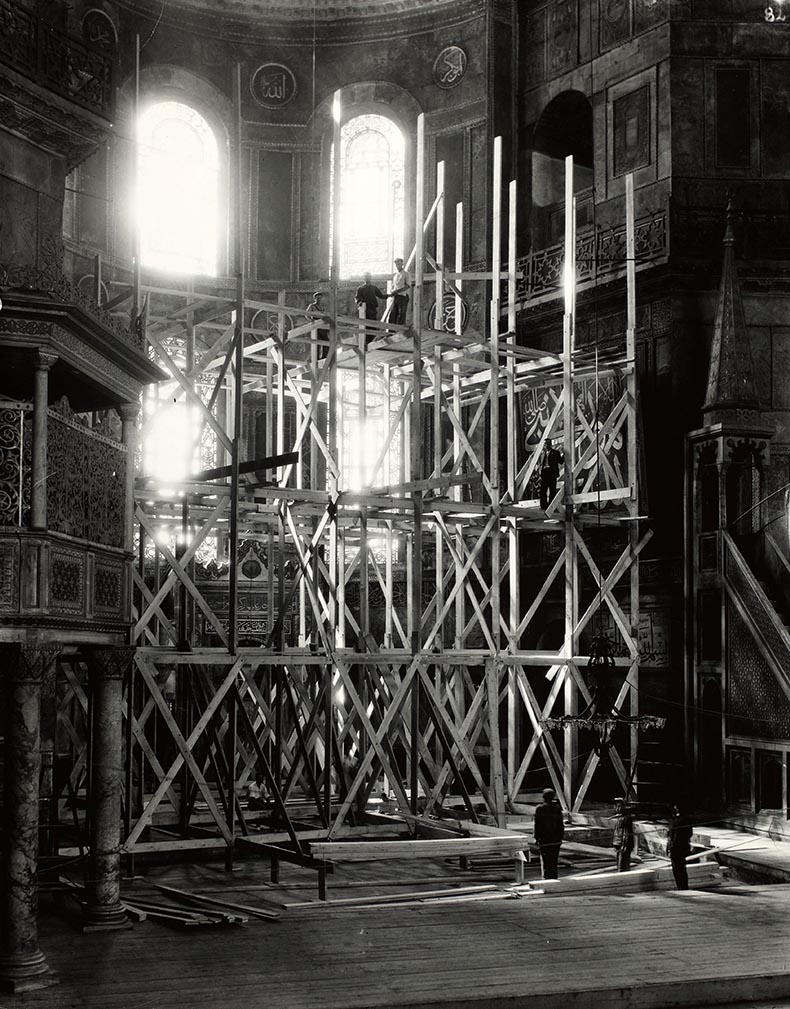 Here you can see them erecting a wooden scaffold to work on the apse mosaic and the marble revetment. They would have done it the same way in Byzantine times when they put up the mosaics or repaired them. They have covered the marble floor to protect it. Constantinople was surrounded with forests and wood was always inexpensive and easy to harvest and transport to the city. Most of the homes were built of wood.
Here you can see them erecting a wooden scaffold to work on the apse mosaic and the marble revetment. They would have done it the same way in Byzantine times when they put up the mosaics or repaired them. They have covered the marble floor to protect it. Constantinople was surrounded with forests and wood was always inexpensive and easy to harvest and transport to the city. Most of the homes were built of wood.
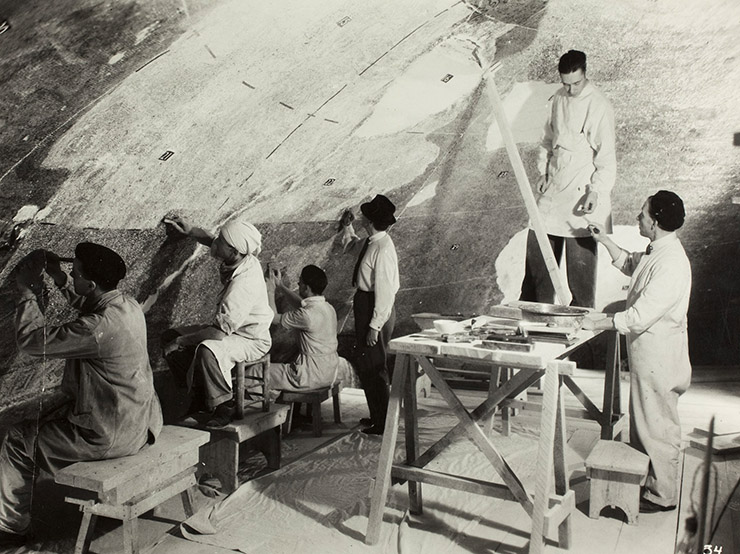
Above you can see restorers working on the mosaic in the 1930's after the scaffold was completed. They have marked off the apse into sections and are moving from square to square. The man in the hat is Professor Thomas Whittemore, the founder of the Byzantine Institute. He persuaded the Turkish President to allow the project to proceed and raised the money from his friends. The guys standing are the Wright brothers, the man in the turban is Alywn Green. The man on the far left is Ernest Hawkins.
DESCRIPTION OF THE MOSAICS
DOWNLOAD THE PDF
The Apse Mosaics of St. Sophia at Istanbul. Report on Work Carried out in 1964 by Ernest Hawkins and Cyril Mango
THE VIRGIN AND CHILD
The Virgin who occupies the center of the apse semi-dome is represented enthroned with the Child seated in her lap. She rests her right hand on the Child's right shoulder, and her left, which holds a handkerchief, on the Child's left knee. The figure is complete except for an area of loss (roughly o.80 m. high and 0.70 wide) on the Virgin's left side corresponding to her left forearm and elbow, the Child's left hand, and part of the upper cushion placed on the throne. There is, furthermore, a fissure, caused by a structural crack in the shell of the semi-dome, which runs down the middle of the figure to the apex of the central window. It is clear that the mosaic was executed at a time when the semi-dome had already undergone the deformations it exhibits today.
With regard to the proportions of the figure, certain considerations ought to be borne in mind. The dimensions given below have been measured on the curve and show that, in general terms, the scale diminishes as one goes higher up the figure. This diminution, though not consistent (thus, the Virgin's feet are too small even by normal standards), is unmistakable: the Virgin's head is too small in relation to her total height (the proportion is 1: 8.3), her right hand is markedly smaller than her left hand, and the Child's figure, too, starting with rather large feet, loses scale towards the top. This anomaly cannot be explained by any rational attempt on the part of the artist to counteract optical distortion. Since the figure of the Virgin is placed above the windows of the conch, it lies, not as normally, on the quadrant of a circle, but in the upper half of a quadrant, and if we drew an imaginary line from the top to the bottom of the composition, this line would be at 300 to the horizontal. To see the mosaic at right angles from the ground one has to stand at the eastern end of the building, in line with the eastern exedrae. From the middle of the nave the top part of the mosaic is foreshortened more than its lower part, so that the proportion of head to body becomes about 1:9. It is only if one stands directly below the mosaic (a position inaccessible to the mediaeval worshiper) that the proportions become more nearly normal. In other words, the mosaicist laid out the figure as if it were meant for the lower ring of a dome, to be viewed straight up, as, for example, in the Ascension dome of St. Sophia, Salonica, where the figures of the Virgin and apostles are correctly lengthened with relation to their heads. Note that in the apse of the latter church the head of the enthroned Virgin is, on the contrary, disproportionately big. What surely happened in our case is that the mosaic of the Virgin was designed from a platform more or less level with the windows of the apse semi-dome. If we suppose that the artist took his vantage point directly below the crown of the semi-dome or a very short distance further west, as he would have had to do in order to see the whole composition in one glance, then the proportions of the mosaic become reasonably normal, and, even more markedly, which was photographed from a point below the bema arch at the level of the marble cornice (proportion of head to entire body I:6.6). For further confirmation of our suggestion, note that in the images in this article the seat and footstool of the Virgin's throne appear nearly horizontal and the posts of the throne vertical, whereas when the mosaic is seen from below the seat seems to sag in the middle and the posts to come apart at the base. In other words, the artist gave no thought to the appearance of the mosaic from the ground: he designed the composition free-hand and gave it the proportions which looked correct from his scaffold. Naturally, he could not have used any form of squared up sketch for transferring the design on to the wall.
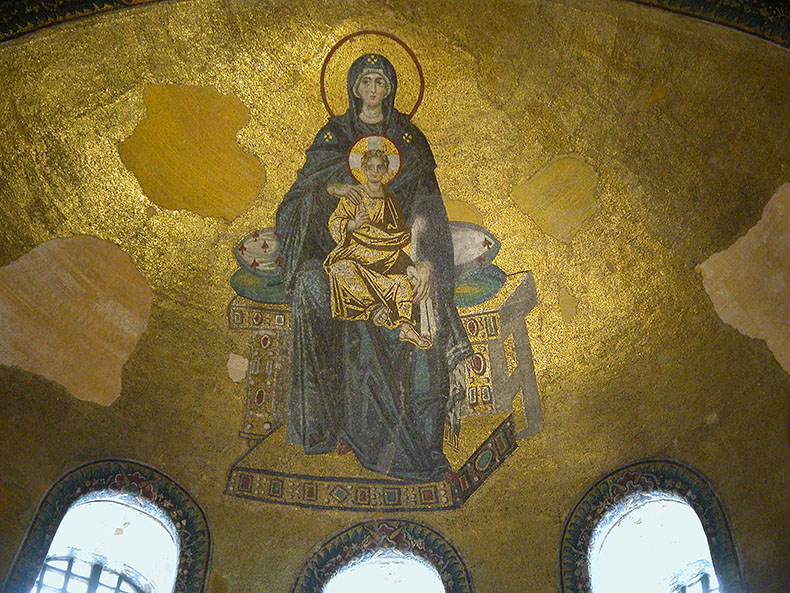

The Virgin's Halo
The outline consists of four rows of red glass tesserae. The gold field of the halo is set concentrically, except for the trim round the head and shoulders which is three rows wide. Mixed with the gold cubes is a tiny proportion of silver ones. The underpainting on the setting bed is red.

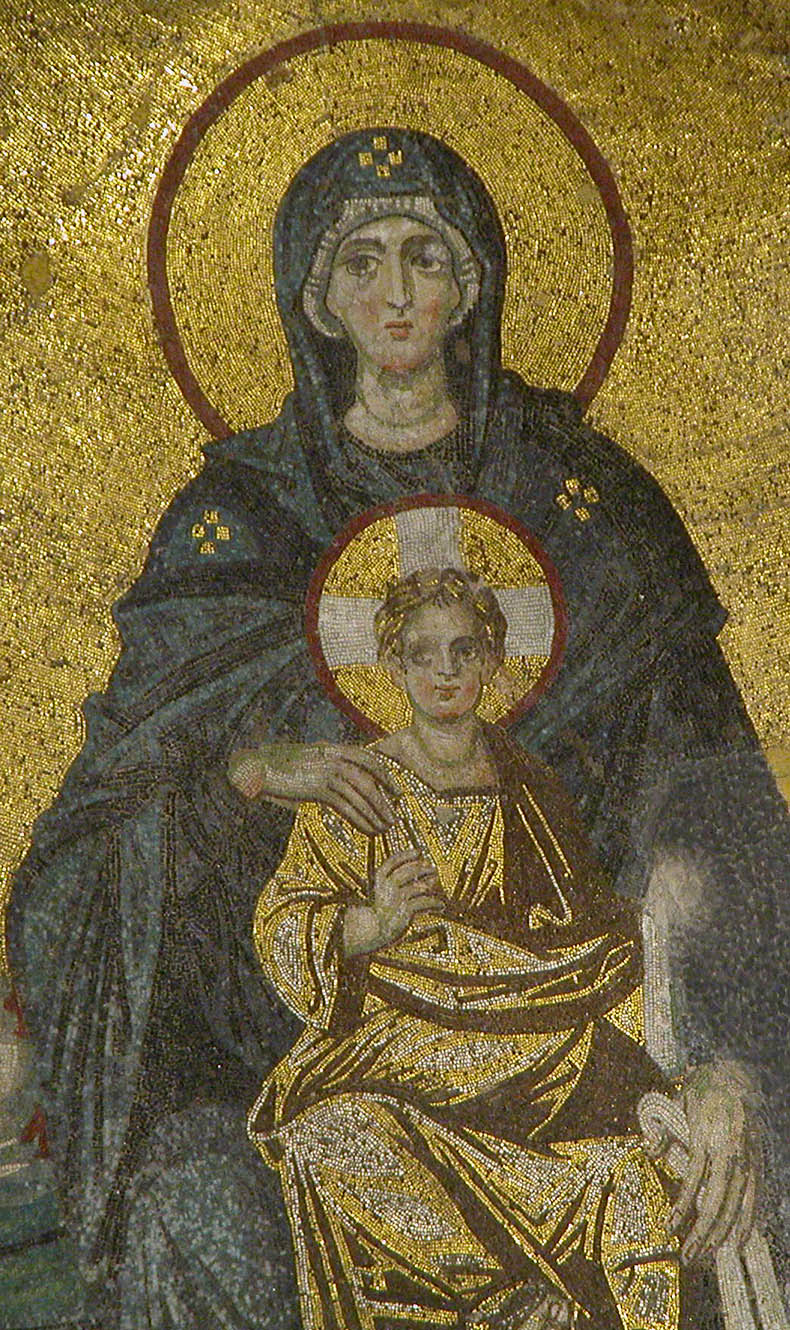
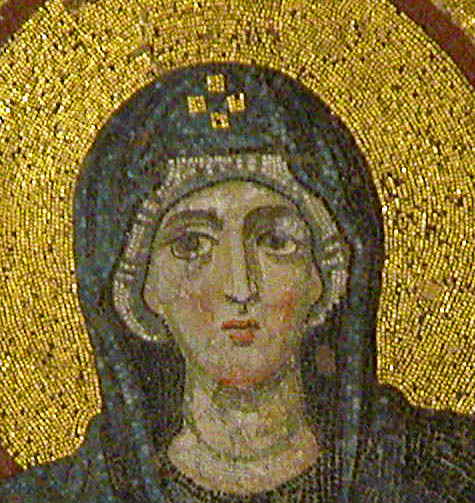 The Virgin's Face and Neck
The Virgin's Face and Neck
The eyebrows consist of a single row of black glass tesserae below which is a shadow line of purple-brown glass. The upper eyelids are in black glass, the lower eyelids in purple-brown glass. Whites of eyes: the lighted parts are of white limestone cubes, the shaded parts of olive glass. Pupils: the outline and centers are of black glass, the remainder of purple-brown glass. Intentional damage has been caused to both eyes perhaps by Fossati's workmen. The ridge of the nose consists of two vertical rows of fine-grained white marble, followed on the right (illuminated) side by one row of coarse-grained Proconnesian white marble and two rows of cream marble; on the left (shaded) side by one row of pink marble, one row of purple-brown glass, two rows of olive glass, and two rows of yellow-green glass. The tip, like the ridge, of the nose is in smooth white marble. The nostrils are of black glass, the dimple shadow under the nose is in purple-brown glass. The parting line of the mouth is in red glass. The upper lip, the high light on the lower lip and the corers of the mouth are in vermilion glass. The shadow under the mouth is in purple-brown glass.
The flesh tones are in the following materials: fine-grained white marble, Proconnesian white marble, milky off-white glass (used along the right edge of the face), cream marble and three shades of pink marble. There is a touch of vermilion glass on the tip of the chin, and three lines of it on the left cheek.
The shaded parts of the face consist of purple-brown glass, olive glass, light green, and yellow-green glass. The ears are not delineated. The tesserae used in the face are occasionally as small as 3 mm. square. There are small areas of loss on the forehead, under the right eye, and on the tip of the chin.
Under the chin there is a fairly heavy shadow in purple-brown glass and green glasses, the latter extending to the shaded (left-hand) side of the neck. There is, further, a line of light green glass at the base of the neck.
The Virgin's Right Hand
The lower line of the fingers and of the back of the hand is in red glass. The flesh tones are in fine-grained white marble, Proconnesian white marble, and three tones of pink marble; the shadows are in yellow-green glass. The knuckles on the index and middle fingers as well as the fingernails are imperceptibly indicated in fine-grained white marble. The nails are not outlined as in the left hand.
The Virgin's Left Hand and Handkerchief
The thumb and fingers are outlined on the spectator's right side with mat brown glass which also forms the heavy shadow on the back of the hand. The lighter shadow near the wrist as well as one line on the left side of the ring finger are in yellow-green glass. The flesh tones are the same as in the right hand. The nails are outlined in red glass.
Folded over the thumb is a handkerchief consisting of white Proconnesian marble, outlined on the spectator's left side with two rows of white limestone tesserae. Limestone is also used for the tasselled fringe on the left, but not on the right extremity of the handkerchief.
 The Virgin's Feet
The Virgin's Feet
The feet, which are disproportionately small (the exposed part of the left foot being only 0.20 m. long), are shod, as usual, in red slippers. Originally, the slippers were rendered in two tones: red glass was used for the shaded parts, while the lighted parts consisted of cubes dipped in red lead paint. The paint has largely flaked off, revealing both glass and stone tesserae of different colors, gold, silver, green, blue, etc.
The Virgin's Garments
The kerchief covering the Virgin's head is of white Proconnesian marble with a shadow line and sets of triple fold lines in turquoise glass. The kerchief is outlined against the face with a single line of black glass tesserae. The Virgin is dressed, as usual, in a stola and a maphorion. Both are of the same color. The stola is visible below the neck, at the cuff of the right arm, and from the knees down. The stuff of the garments is indicated by means of only four shades of glass tesserae: turquoise, cobalt blue, dark blue, and black (at times pure black, at times purplish). The turquoise has undergone considerable surface deterioration causing it to turn a paler shade. This is especially noticeable at the Virgin's right knee, and produces, when viewed from a distance, the deceptive appearance of an exaggerated high light. The maphorion is adorned with cruciform segmenta, each consisting of four little gold squares; one of these ornaments is placed in the center of the hood and one on each shoulder. The edge of the maphorion where it falls down from the left arm has a double edging in pale turquoise glass with the nigh lights indicated in white marble. Attached to the hem are tassels consisting of two or three threads tied in a knot. The tassels are rather schematically drawn; they are in white marble where they are against the blue of the maphorion and in blue glass where they are against the gold of the footstool.
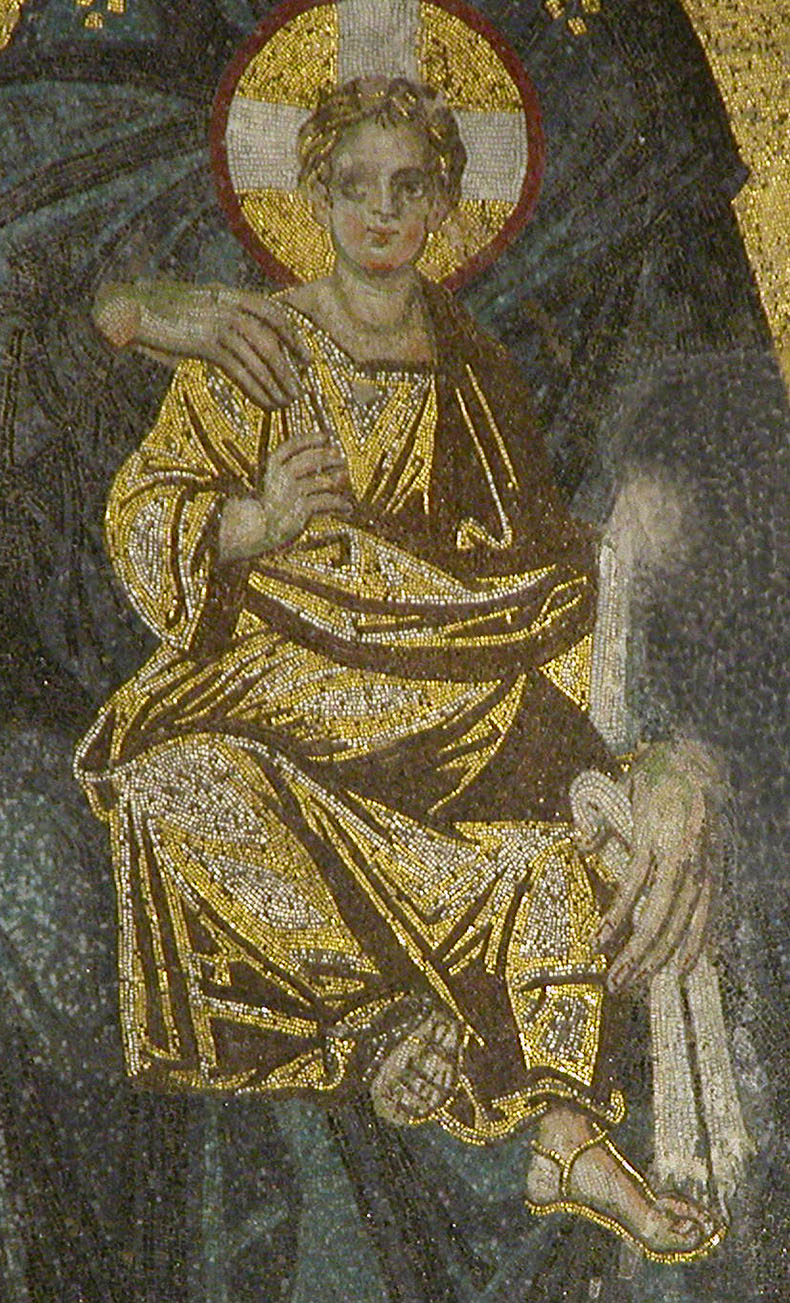
The Child's Halo
The halo is outlined with three rows of red glass tesserae. The arms of the cross, which are nearly straight, are in white Proconnesian marble. The field of the halo is in gold, set concentrically. There is no admixture of silver cubes in the gold.

The Child's Head
There is intentional damage to the right eye. Further areas of loss occur above the right ear, at the top of the head, and down the left side of the hair to a point just above the left ear.
The Child is shown fair-haired. The lighter strands of hair are in yellow glass and yellow-green glass, the darker strands being in clear brown glass (gold cubes turned sideways) and mat brown glass. Accents are provided by occasional gold strands. A triple tuft falls over the middle of the forehead. The flesh tones of the face and neck are of the following materials. Fine- grained white marble is used for the projecting or high-lighted parts, viz. the center of the forehead, above the eyebrows, one vertical row down the ridge of the nose and one transverse row across the top of the bridge, the tip of the nose, the top of the chin, and a few lines under the eyes. The grey vein of Proconnesian marble provides light shadows on the ridge of the nose (vertically, on either side of the white line), between the eyebrows, on the right side of the forehead (inside the green shadow line), under the eyes, and in a small patch to the left of the mouth. Three tones of pink marble are used, the palest mostly in the forehead, the two more intense tones in the cheeks and chin. Cream marble outlines the nose and nostrils. There are three tones of green glass: light yellow-green, yellow-green (under the eyes, on the right side of the neck, and on the right side of the forehead) and pale green (outline of the right jowl). Olive glass is used in two tones (one yellowish) to outline the entire left side of the head and in conjunction with purple-brown glass in the shadows round he eyes and under the mouth. Purple-brown glass outlines the nose and eyes.
The eyebrows, eyelids, nostrils, and corners of the mouth are in slightly purplish black glass. The parting of the mouth is in deep red glass. Vermilion glass is used in the lips, small spots on the cheeks, a spot on the bottom part of the chin, and others on the right ear. The whites of the eyes are in white limestone.
The Child's Right Hand
The right hand, which alone is preserved, is rather clumsily drawn. It is held in blessing, with the ring finger bent back and joined to the thumb. The spaces between the tips of the fingers have been left in unset plaster. The underside of the fingers and hand is outlined in deep red glass. The flesh tones are rendered by means of white marble, grey Proconnesian marble, and three shades of pink marble. The shadows are expressed in yellow-green and pale green glass.
The Scroll
The scroll (partially destroyed), which was held in the Child's left hand, consists of a vertical strip, two to three rows of cubes wide, of mat white limestone; this is surrounded by two rows of Proconnesian white marble. The shadow line on the spectator's right is in two to three rows of pale turquoise glass, which also formed the circular opening at the top of the scroll.
The Child's Feet
The right foot, covered except for the toes and the lower part of the instep, is shown in head-on foreshortening. The left foot is in profile (length 0.34 m.). The feet are shod in sandals, the sole of which consists of a double row of gold cubes, and the thongs of one row of gold, bordered with clear brown glass. The flesh tones comprise fine-grained white marble, Proconnesian white marble, and three tones of pink marble. The shadow line along the sole of the left foot is in light yellow-green and yellow-green glass. The right foot has a green shadow line separating the toes from the instep.
The Child's Garments
As in the case of the Virgin, there is no distinction in color between the tunic, of which the right sleeve and the portion covering the breast are visible, nd the himation which envelops the rest of the body. The basic color is gold. The high-lighted or forward parts are in silver, the shadows in mat brown glass. Darker fold lines are in transparent glass (gold cubes placed on their side), which is mostly brown, sometimes greenish.

The Throne
The throne on which the Virgin is seated is seen from the right and slightly from above. Owing to faulty perspective, its construction is not at once apparent. The horizontal seat is meant to be supported on two pairs of square posts, each pair being braced together by a cross-bar. The front post on the spectator's left has a ball base, but this is not the case with the rear post on the right. The right and left sections of the throne are differently proportioned (thus, the thickness of the seat is 0.2I to 0.245 m. on the left and 0.32 on the right) and the cabochon stones decorating the respective parts do not line up. There are some further inconsistencies which will be described below.
The receding parts of the throne are made of a coarse granite which was originally of a brown color, but has now paled to a grey of unsuitable shade. The granite tesserae are of varying sizes up to 2 cm. long, and have been untidily set in horizontal rows, except in the cross-bar on the spectator's right, where they are set on the segment of a circle. Large and small tesserae have been used indiscriminately.
The horizontal seat of the throne is outlined on the spectator's left side with the same grey granite, except that about two-thirds of the upper outline are in three rows of mixed brown glass, mat and clear. On the spectator's right, the front and back outlines of the top of the seat are in clear brown glass, while the sie of the seat and the lower front edge are outlined in granite.
The front of the seat is decorated with cabochon stones, alternately rectangular and oval. Between each stone are three pearls set in a vertical row. The stones, which are made alternately of green and red glass tesserae, have silver mounts outlined in brown glass. The pearls are of Proconnesian marble and have shadows of brown glass.
The left front post of the throne is outlined on the spectator's left with grey granite, except for the bottom 16 cm. of the outline which is in brown glass. The decoration of the post consists of two oval and two rectangular stones and ten pearls. The oval stones red, the rectangular ones green. The mounts are, once more, silver, but they are outlined with granite cubes. The four top pearls have brown glass shadows, the four middle pearls shadows of grey granite, and the two bottom pearls blue glass shadows. Of the two bottom pearls, the one on the right is disproportionately big and its blue shadow cuts into the vertical outline of the post. The base of the post is outlined in dark blue glass.
The front post on the spectator's right is decorated with a red oval stone and a pair of green rectangular stones, as well as with pearls. As we have said, these stones do not line up with those on the left-hand post for the reason that the seat of the throne is considerably wider and comes lower on the right side than it does on the left.
The Cushions
Two cushions are placed on the seat of the throne. Although the Virgin is meant to be resting on them, the cushions give the impression of being laid behind her back. The upper cushion has its lighted parts in white Proconnesian marble. Light shadows are in grey Proconnesian marble, medium shadows in pale turquoise glass, and heavy shadows in turquoise glass. The upper cushion is ornamented with ivy leaves in red glass tesserae. The greater part of this cushion on the spectator's right has been destroyed. The lower cushion has its high lights in yellow glass mixed with yellow-green glass. The main body of the cushion is in leaf-green glass, while medium shadows are in turquoise glass, partly decayed, and heavy shadows in dark blue glass.
The Footstool
The footstool is shown in reverse perspective and is placed to the right of center with regard to the throne. The front of the footstool is 2.34 m. long at the base; the height of the side increases from 0.33 m. at the front to 0.365 at the rear. The front, like the top of the footstool, is gold, whereas the side is shaded in mat brown glass with a sprinkling of gold cubes. The outline is in dark blue glass, the upper one of the front side being the heaviest (five rows wide). The lower horizontal and two vertical outlines of the front side are four rows wide, the lateral outlines three rows wide. The back of the footstool has no blue outline.
The front and side of the footstool are decorated with cabochon stones and pearls. The front has a diamond-shaped stone in the middle and three rectangular stones on either side; the side, an oval stone in the center flanked by two rectangular stones. The mounts of the stones are gold with blue outlines. As on the throne, the stones are red and green alternately, but here there is an interesting refinement: some of the stones (the third, fifth, sixth, and seventh counting from the left) are in two tones of the same color. In the case of red stones, the deeper tone is provided by red glass, the lighter by means of cubes of different colors that were dipped in red lead paint. In the case of green stones, leaf-green and blue-green glass provided the two tones needed. Observation of this segment of the mosaic makes it possible to determine the sequence in which the work was carried out. The figure of the Virgin and Child was made first. Secondly, the mosaicist made the blue outline of the footstool, the tesserae of which conform to the lower line of the Virgin's stola. Thirdly, he bordered the upper and lower outlines of the front of the footstool with four horizontal rows of gold cubes. Next, he set the stones and pearls, working from right to left and from bottom to top: note that the mount of the central diamond-shaped stone is, for lack of room, amputated at the top, as are also the two one on each side of it.
The Gold Background of the Apse Semi-dome
An irregular area of gold ground surrounding the Virgin and Child was set in the same bed of plaster as the figure. The limits of this area are indicated by a suture which is, for the most part, easily discernible. Anticipating our detailed observations on this suture, we may proceed to describe the probable sequence in which the mosaics of the semi-dome were made. In the first place, the entire semi-dome, roughly by the tops of the windows, was covered with a preliminary coating of plaster containing an appreciable proportion of chopped straw. Upon this first coating was laid a second thickness of plaster corresponding to the area intended for the figural composition and allowing sufficient room all round it. The setting bed of finer plaster was then applied, probably in smaller sections, although the boundaries between them cannot be traced. As usual, the artist proceeded to paint upon the setting-bed the subject of his composition, and in so doing he colored yellow the background forming the immediate surround of the figure. The figural mosaic was then made, starting at the top and working downward. The composition turned out to be somewhat taller than originally envisaged, with the result that its lower extremity came to the very edge of the bed of plaster that had been laid and, incidentally, rather too close to the top of the central window. It may be observed that the rear right post of the throne came so close to the edge of the plaster that its corner had to be rounded off. Possibly, additional patches of plaster had to be added to accommodate parts of the composition, and this may explain some of the irregularities we have observed, e.g., the change in the material used for the outline at the lower extremity of the left-hand post of the throne. A trim of gold tesserae, two to four rows wide, was then made round the entire composition, after which the mosaicist proceeded to cover with gold as much of the plaster bed as had been laid. He knew that the gold cubes had to be set on concentric curves, but he did not take the trouble of marking out exact setting-lines, with the result that he sometimes misjudged the direction of the lines and had to correct himself by inserting wedge-shaped patches of gold mosaic. After this process had been completed, the remainder of the conch was covered with a second, and then a third layer of plaster. This time the craftsman took a center point immediately above the Virgin's head and probably using a long cord attached to a pin, marked out a number of concentric semicircles. A small area of loss to the south of the composition and more or less level with the Child's head has enabled us to ascertain that these guide-lines were indicated in red paint upon the second coat of plaster. The over-all, gold background was laid with the help of these guide-lines, but with the inevitable result that the rows of tesserae did not exactly line up with those in the gold ground belonging to the immediate surround of the figure.
The average size of the cubes used in the background is 5 to 6 mm. square, and there are roughly 225 of them per 10 cm. square. Mixed with the gold is an appreciable proportion of silver tesserae. This admixture is least in the immediate surround of the figure and more considerable in the over-all background, but there is no consistency about the proportion of silver, which in places is as much as 10 percent, in others almost nil. In addition to the silver, there is also a sprinkling of red glass cubes in the over-all background, a peculiarity we have also observed in the mosaic of St. Ignatius Theophoros in the north tympanum. The underpainting on the setting-bed of the over-all gold background (as distinct from that of the gold surround of the figure) is red.

THE INSCRIPTION
The face of the apse semi-dome was occupied by an inscription commemorating the restoration of religious images after the defeat of Iconoclasm. The full text, preserved in the Palatine Anthology was as follows: "The images which the impostors had cast down here pious emperors have again set up." Today, only the very beginning and end of the inscription remain. The same letters were uncovered by the Fossati brothers in 1847-49, whose record of them is, however, rather confused. The identification of the preserved fragments with the distich in the Anthology is due to Antoniades. The inscription was written in capital letters 0.40 m. high on a gold band 0.54 to 0.57 m. wide. The letters are in dark blue glass. The background is gold with a small admixture of silver, set in widely spaced rows of angled tesserae, as was often done on vertical surfaces. The setting-bed under the gold was painted yellow.

THE GARLAND BORDERS
Sumptuous garland borders were placed on either side of the commemorative inscription (i.e., one running round the soffit of the bema arch along its eastern edge, the other convex and folded over the rim of the apse semi-dome), along the base of the apse semi-dome, and under both archangels at the springing of the bema arch: roughly seventy running meters in all, of which about forty-four are preserved, either entirely or in part. Furthermore, a similar garland border at a somewhat smaller scale, and again convex, folds round the interior edges of the five windows of the apse, totalling about thirty-one running meters.
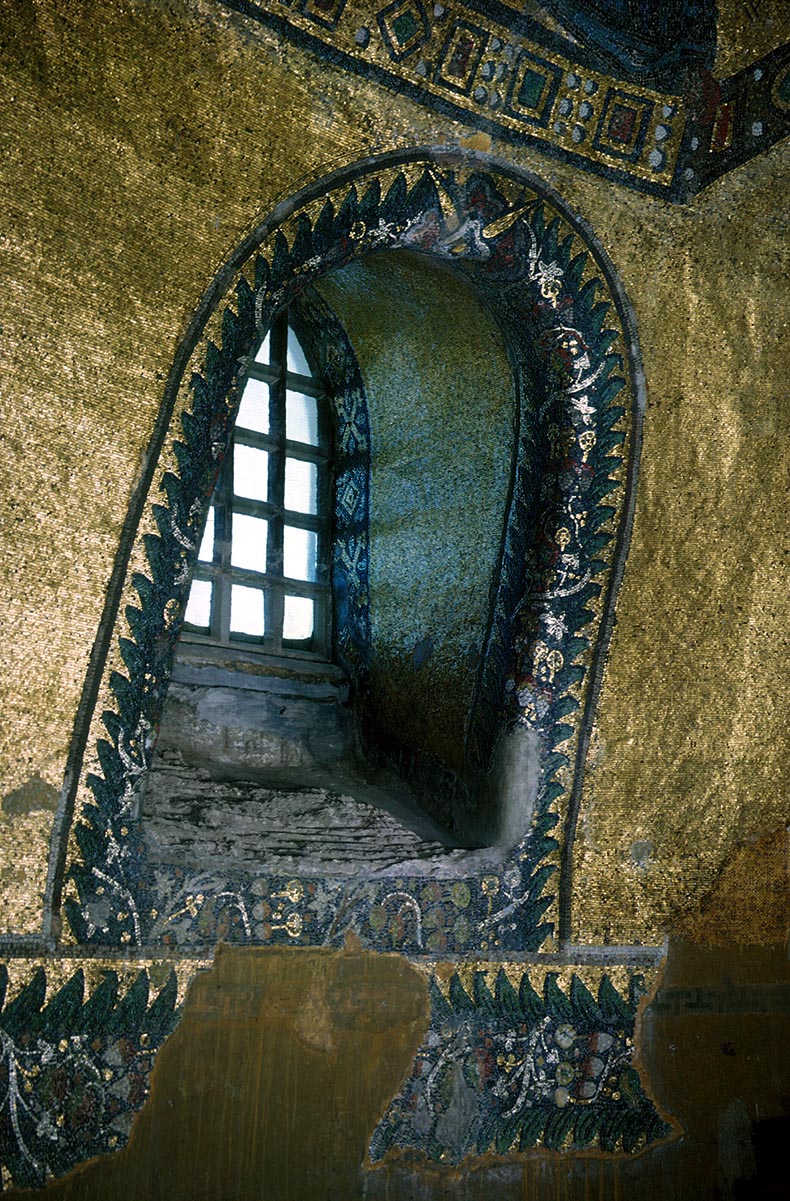
The garland borders are delimited by a double outline normally consisting of three rows (two round the windows) of terracotta tesserae or marble tesserae dipped in burnt umber paint, and of two rows of white marble tesserae. Within this outline the background is gold with an admixture of silver cubes. The garland itself consists of a dark blue sheaf bordered on either side with a row of green bay leaves. The leaves are inclined in the direction in which the garland is proceeding, and the tips of the leaves are, here and there, bent over backwards. Round the blue sheaf is twined spirally a silver (occasionally white marble) ivy vine. Attached to this vine, in addition to normal spade- shaped leaves, are five-petalled flowers, clusters of berries, and "pears," all usually in silver. The space between each turn of the vine is filled with a variety of vegetal motifs, to wit, curving stems bearing pomegranates, pears, and circular flowers on short straight stems. The pears and flowers are usually arranged in rows of three. In the intervening spaces are sprinkled circular berries, either red or gold.
Wherever the garland has to turn at a right angle, it is contained in a kind of L-shaped tube which gives the appearance of being made of silver. The rotundity of this tube is indicated by parallel bands of colors, usually white limestone or marble in the middle, shading off on either side first to silver, then to turquoise, then to dark blue. The ends of the tube are folded over, and there is a two-tone red ribbon twined round the tube. If we conceive the garlands as proceeding out of these corner tubes, there is a center point at which two converging garlands meet. This point is occupied by a star-shaped flower, such as the one directly under the south archangel. Another, incompletely preserved, flower remains at the apex of the bema arch. The flower under the archangel has a center of turquoise glass, four trefoil petals in red glass and terracotta, and four pointed gold petals. A similar flower occupies the apex of each of the five windows of the apse.
The window borders are of similar design, except that the horizontal band at the base of the windows (it is preserved in its entirety under window No. 3, and in part under window No. 2), being only about 0.25 m. wide, has the sheaf without the green leaves. In windows 2 and 3 it is clearly seen that the vertical bands of border were made first, and the horizontal band next on a separate bed of plaster, with a straight joint on either side.
Given the considerable length of the garland borders, it is only natural that we should encounter in them some differences of detail. The most carefully executed stretch is at the base of the apse semi-dome, between windows 1 and 3. The length of border between window No. 1 and the face of the apse is of somewhat looser construction: the round flowers and pears (which here have long stems) are not lined up, as elsewhere, in neat vertical rows, and there are no pomegranates. In spite of such inconsistencies, there is an undeniable uniformity both of technique and materials in all of the garland borders. Especially noticeable is the extensive use throughout the garlands and always in the same contexts of painted tesserae. In addition to the red and white outline, these occur in the ribbons that are looped round the corner tubes, in the pears, the pomegranates, the stems and in the small round berries. The latter appear to have been further touched up with red lead paint, as is also the case with the feet of the south archangel.
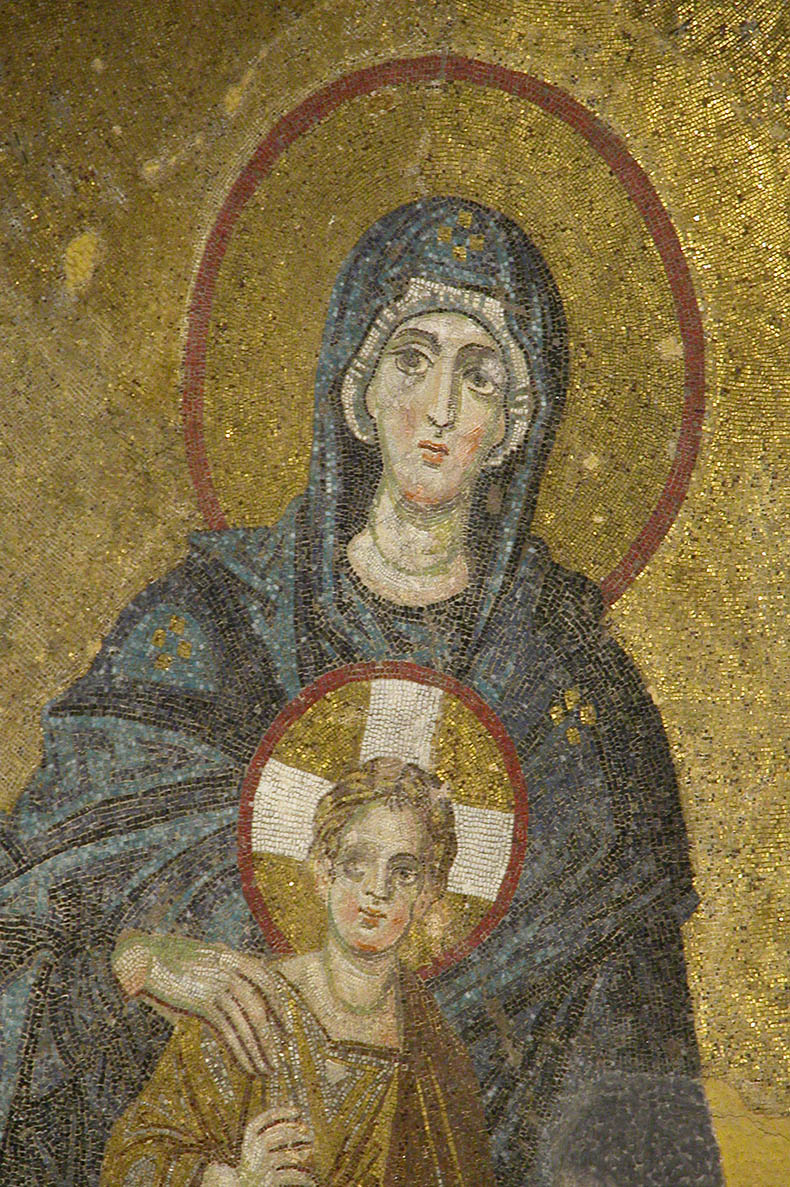 TEXTUAL EVIDENCE
TEXTUAL EVIDENCE
Mediaeval sources contain very little direct information on our mosaics. An attempt to collect and interpret the textual evidence has previously been made by one of us, but the conclusions expressed on that occasion are in need of correction. We shall, therefore, proceed to review the evidence once again. The first of the relevant texts is contained in the Pilgrimage of Antony, archbishop of Novgorod, who visited Constantinople in 1200. He says that the painter Lazarus "for the first time represented in Constantinople, in the sanctuary of St. Sophia, the Holy Mother of God holding Christ, and two angels." Lazarus flourished in the first half of the ninth century and we shall have more to say of him later.
The second text requires lengthier analysis. It is a sermon of the Patriarch Photius delivered in St. Sophia on March 29, 867. In the extant manuscripts this sermon is entitled "Of the same most-blessed Photius, Patriarch of Constantinople, homily delivered from the ambo of the Great Church, on Holy Saturday, in the presence of the Christ-loving Emperor, when the form of the Theotokos had been depicted and uncovered." The homily was indeed delivered, as is made clear by its text, in the presence of the Emperors Michael III and Basil I, and it deals with two noteworthy achievements, or triumphs, of the Orthodox cause. The first of these achievements was the conversion of a large body of heretics, the so-called Quartodecimans. The second, which the speaker regarded to be of far greater importance, was the uncovering or unveiling of an image of the Virgin and Child. Indeed, this image symbolized the definitive defeat of the Iconoclast heresy and the ceremonial inauguration of an Orthodox era: as the orator expresses it, "If one called this day the beginning and day of Orthodoxy (lest I say something excessive), one would not be far wrong."
It is made clear that until that time St. Sophia had remained deprived of representational images: its "visual mysteries" had been scraped off by the Iconoclasts, and "it had not yet received the privilege of pictorial restoration. The Great Church had looked melancholy, disfigured by the scars of heresy, shorn of its glory. But now that the image of the Theotokos had been restored, raised from the depths of oblivion, the images of the saints would rise in like fashion." In other words, an entire iconographic cycle was under execution or being planned. The sermon concludes with the wish that the two emperors should "consecrate the remainder of the church, too, with holy images."
It must be admitted that Photius does not specify the location of the newly unveiled image of the Virgin, nor does he say that it was a mosaic. In describing it, he speaks of "colors", "painting" from which some scholars have concluded that the image was a painted one. Furthermore, the expressions he uses in speaking of the image appear at first sight somewhat inappropriate to the mosaic that is now in the apse. He says that the Virgin which could be rendered either "stands motionless" or "is set up motionless;" and that the Christ Child was "reclining as an infant". Taking these expressions in their literal sense, one of us has previously suggested that Photius was referring not to a seated Virgin, but to a standing Hodegetria holding a reclining Infant in her arms, a type that was in fact used in the ninth century.
Such an interpretation is not, however, mandatory, and it has rightly been pointed out that Photius' language is not inconsistent with the mosaic in the apse.
The problem can now be formulated by means of the following alternatives:
I. Photius is indeed speaking of a mosaic in the apse, but this was an earlier mosaic which was later replaced by the one now in existence.
2. Photius is speaking not of an image in the apse, but either, i) of a mosaic that was elsewhere in St. Sophia or, ii) of a portable icon.
3. Photius is speaking of the very mosaic that is now in the apse.
The first alternative can be immediately ruled out in view of the fact that the existing mosaic in the apse is not later than the inscription commemorating the restoration of images by "pious emperors."
Alternative 2(i) can also be excluded. The only other mosaic of the Virgin that may be considered in this connection was at the crown of the great western arch. This mosaic was, however, made by the Emperor Basil I after the earthquake of January 9, 869.
Alternative 2(ii) is equally unacceptable. If all that happened on March 29, 867 was that a portable icon of the Virgin had been placed somewhere in St. Sophia, then Photius is guilty of the wildest hyperbole. There is yet a further difficulty: if Photius was prompted to such lofty flights of rhetoric by the presence of a portable icon, are we to assume that the apse mosaics had already been made by 867 or that they had not yet been made? If we assume that they were already in existence and had been put up, say, around 855, then Photius' homily ceases to make any sense at all. If, on the other hand, we suppose that the redecoration of St. Sophia with mosaics was begun after 867, we only create a further and quite unnecessary difficulty. It is remarkable enough that the first figurative mosaics of St. Sophia should have been made no sooner than twenty-four years after the Feast of Thus, we are inevitably led to the third alternative. Photius' homily must have been delivered upon the completion of the Virgin and Child that is still extant in the apse. In other words, both the mosaic of the Virgin and, most probably, the mosaics of the two archangels were completed in 867. The "pious emperors" mentioned in the commemorative inscription are Michael III and Basil I.
We may now return to the statement made by Antony of Novgorod and consider whether our mosaics could be attributed to the painter Lazarus. First, however, let us be clear about the intrinsic worth of this statement: since Antony is merely reporting something he was told in 1200, he has as much claim on our credence as a present day tourist explaining, on the authority of the local cicerone, why the Blue Mosque has six minarets. What we know about Lazarus from more or less contemporary sources is this: He was of Chazar extraction and took up both painting and the monastic life at an early age. An outspoken critic of the Emperor Theophilus (829-42), he was subjected to torture and imprisonment, but continued nevertheless painting icons. To punish the monk's obduracy, the Emperor ordered that the palms of his hands should be burnt with leaves of red-hot iron. Barely surviving this ordeal, Lazarus was released from prison at the instance of the Empress Theodora, and took refuge in the monastery of St. John tou Phoberouon the outskirts of Constantinople. There he painted an icon of the Baptist, which was still extant in the tenth century and performed many cures. At the restoration of Orthodoxy (843) Lazarus defied the wishes of the government by refusing to countenance the "whitewashing" of the deceased Emperor's memory; he was nevertheless commissioned to execute the mosaic image of Christ above the bronze portal of the imperial palace, which he did with his own hands before 847. Adorned with the title Confessor, Lazarus now took an active part in Church politics. His allegiance lay with the extreme "right-wing" monkish party, as was already made clear by his intransigent stand in 843. The Synaxarion informs us that he undertook a mission to Rome "on behalf of the doctrines and traditions of the Fathers and the apostles;" that he returned "in splendid fashion," and was once again sent to the same destination "because of the same matters," but that he died on the way. His body was brought back to Constantinople and buried in the monastery of Evandros outside the walls.
The "apostolic service" which Lazarus was delegated to perform was in fact to obtain the Pope's consent to the deposition of Gregory Asbestas, bishop of Syracuse. He seems to have arrived in Rome in 855, soon after the accession of Benedict III, and brought splendid gifts to the Pope, namely, a Gospel book, a chalice, two hangings of purple cloth, etc. The gifts were received with thanks, but the Pope appears to have refrained from pronouncing judgment on Asbestas. Lazarus' second mission cannot be dated so accurately, except that it must have taken place after 865; for in his famous letter to the Emperor Michael III, dated September 28, 865, Pope Nicholas I stipulates, "Mittuntur etiam de parte Ignatii archiepiscopi quidem Antonius Cyzici, Basilius Thessalonicae ... atque Lazarus presbyter et monachus, qui dicitur Chazaris." Unless, therefore, the Pope was misinformed, Lazarus was still alive at the time. We do not know, however, when he set out for Rome or, indeed, whether he did so before or after the downfall of Photius (September 23, 867).
From the viewpoint of chronology, therefore, we cannot rule out the attribution of the apse mosaics to Lazarus. What makes this rather unlikely, however, is that he was one of the most determined adversaries of the Patriarch Photius. Gregory Asbestas was a close friend of the Patriarch's and was among the bishops chosen to consecrate him in 859; yet Lazarus, as we have seen, had gone to Rome to obtain Gregory's condemnation. And if, in 865, Pope Nicholas wished to have Lazarus plead Ignatius' case in Rome, this was surely because Lazarus, along with Antony of Cyzicus and a handful of other staunch Ignatians, was known for his attachment to the deposed Patriarch. Under the circumstances, it is difficult to believe that Photius would have chosen his declared enemy for a task in which he took such great personal pride, namely, the restoration of the mosaics of St. Sophia. How the attribution of the apse mosaics to Lazarus came about it is now impossible to say: perhaps simply because Lazarus was the most famous - in fact, the only famous painter of the period; on the other hand, it may have been a deliberate invention calculated to deprive Photius of the credit of having restored the mosaics.
For the sake of completeness, we may examine a few other mediaeval texts, although their relevance to the history of the apse mosaics is at best incidental. In the course of the eleventh century the interior of St. Sophia underwent a "facelifting." While the Emperor Romanus III (1028-34) gilded the capitals, the Patriarch John Xiphilinus (1064-75) is said to have "renewed all the images of the saints." In a passage rather lacking in clarity, Michael Psellus gives the following details concerning the restoration carried out by this Patriarch: "In the first place, the great and most - holy temple of divine Wisdom, which in greater part and especially round the bema was not overly decorated, and those parts of the superimposed arches and ceiling which were cracked and altogether unadorned-both these parts he adorns and embellishes, the former by encompassing it, as it were, with gold crowns and honoring it with artful images, whereas the latter he repaired splendidly and challenged the ancient beauty with the new." To judge by this statement, the restoration of the upper part of the church was largely structural, while the images that the Patriarch caused to be made (or renewed ?) were in the bema on ground level. There is, in any case, no reason to suppose that this work affected the apse mosaics, unless it was at this time that the archangel's feet and certain elements of the garland frieze were touched up with red paint.
The disastrous collapse of May 19, 1346 is not known to have affected either the semi-dome of the apse or the bema arch. In the most reliable accounts of this calamity it is stated that the great eastern arch caved in, bringing down that of the dome which it supported; the parts that were subsequently rebuilt being that same eastern arch, the "roof of the bema" (= the eastern semidome) - both completed by October 6, 1346 - the two eastern pendentives, and a little less than one third of the dome (in 1353-4). The evidence of the written sources is in this respect in full accord with conditions observable in the building. In the course of our work we had occasion to strip the western face of the bema arch at its crown because the thick coat of plaster dating from the Fossati repairs was in a precarious condition. The arch was found to consist of two voussoir rings, the inner one being made of bricks of normal size, while the outer one is constructed of bipedales about 0.70 m. long. The bond between the two rings has been broken and the outer one has in places slipped forward by about 4 cm. We have found, however, no evidence of repair in the fourteenth century.
The apse mosaic of the Virgin and Child figures in a dream or vision purported to have been vouchsafed to the future Patriarch Isidore on January 6, 1347, i.e., barely eight months after the collapse. Isidore dreamed that he was in the church of the Blachernae in the midst of a great throng which included the Patriarch (the anti-Palamite John Kalekas). From there they all proceeded to St. Sophia and, while the Patriarch and his suite halted within the Imperial Door, Isidore went to the center of the nave and stationed himself under the ambo. While he was standing there, the Mother of God came out of her image which was above the Patriarch's seat (the latter being presumably in the center of the synthronon) and, approaching Isidore, asked him why he was not occupying the place appropriate to his rank, pointing, as she did so, to the patriarchal throne. She also bade Isidore go up to Kalekas (who was still near the Imperial Door) and express her dissatisfaction in him; this Isidore did and, upon returning, was presented by the Virgin with a gold basket containing a Gospel and a cross. She then ascended back into her image. As for Isidore, he walked up to the sanctuary, hesitant to believe the message that had been imparted to him. The Mother of God had to come down to him once more to express it in even plainer language. Less than a month later Kalekas was deposed (February 2, 1347) and Isidore elected patriarch.
CONCLUSION
The principal result of our investigation has already been stated: the mosaic of the Virgin and Child in the apse of St. Sophia is, in our opinion, the image that was unveiled in 867, and all the other mosaics of Phase 2, namely, the archangels, the commemorative inscription, and the garlands are contemporary with it. This conclusion leads us to make certain further observations.
In the first place, we have found no trace of iconoclastic activity. On a superficial view, the suture round the figure of the Virgin might have been interpreted in the same sense as the cruciform seams in the apses of St. Sophia, Salonica, and the Dormition church at Nicaea, in both of which a mosaic of the Virgin was substituted for an earlier cross. We have been able to show, however, that in our case this suture merely marks the boundary between two successive stages in the execution of the mosaics in the ninth century and offers no clue to what might have been there at an earlier date.
When the archangels were made in the soffit of the bema arch, there was evident concern to preserve as much as possible of Phase 1 gold mosaic. As we have seen, the areas that were cut out must have been carefully calculated since they closely correspond to the contours of the figures. Yet, in the semi-dome of the apse Phase 1 gold mosaic was retained only between the windows, while everything else had to be made de novo. This is certainly surprising in view of the economy we have observed in the soffit of the bema arch: had the pre-867 decoration consisted of a large cross on a plain gold field (as in St. Irene), there is no reason why this gold background should have been removed. The fact that it was could be explained in at least two different ways.
The simpler explanation would be that the Iconoclasts did not tamper with the apse decoration: we have, in fact, no explicit evidence that they did.
The commemorative inscription, it is true, speaks of images which the Iconoclasts had cast down "here" but the connotation of this adverb, probably extends to the whole church and is not limited to the apse. Justinian's original decoration was presumably non-representational and it might have subsisted until 867. In that case we would have to suppose that the Justinianic decoration in the semi-dome of the apse was of a kind that did not lend itself to adaptation. The background might have been filled with clouds or vegetal rinceaux or any other appropriate ornament provided this did not entail a large expanse of unbroken gold.
Alternatively, the mosaics of the semi-dome may have gone through several phases before the ninth century. The Justinianic decoration may have been replaced by a figure of the Virgin or a multi-figured composition in the late sixth or seventh century; if so, such images would have been removed by the Iconoclasts who would have substituted some form of symbolic decoration that they considered fitting-say, a cross surrounded by foliage or shrubs. Finally, the iconoclast mosaics would have been totally removed in 867 because no appreciable portion of them could be usefully retained.
Whichever of these two explanations is closer to the truth, it is evident that the ninth-century mosaics of the apse were designed to have a "triumphal" appearance. This note, so evident in Photius' sermon, is echoed by the profusion of garland friezes. What is particularly telling is that the original geometric surrounds of the apse windows were replaced by garland borders, no doubt with a view to enhancing the pomp of the decoration.
Finally, a word about the geometric borders. We have found two closely related types, both of which have been shown to be Justinianic: a simpler kind in the soffits of the apse windows and a more elaborate kind in the bema arch and round the windows of the northeast exedra. Both kinds were used extensively in St. Sophia: the former in the mosaics, now destroyed, of the west gallery, while the latter bordered some of the main articulations of the interior superstructure of the nave, namely, the four principal arches, the tympana, and the ribs of the dome to about a man's height. This design was imitated in the course of successive restorations of the mosaics in the ninth, tenth, and fourteenth centuries, but the work of these various periods may be distinguished thanks to considerable differences in technique and materials, as we hope to show on another occasion. At the base of the tympana this motif was successfully used in the late ninth century to give the illusion of a decorated parapet-wall "behind" the figures of the Church Fathers and bishops. This device, as we can now see, was not created by the mosaicists of the ninth century, but was imposed upon them by their desire to maintain the unity of the interior decoration.
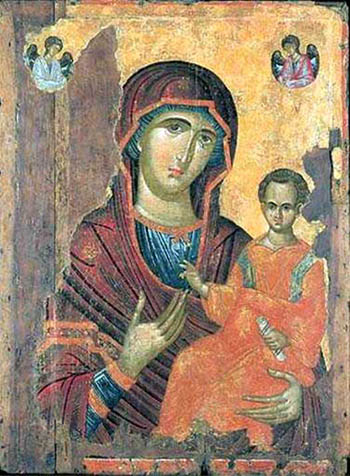 Hodegetria
Hodegetria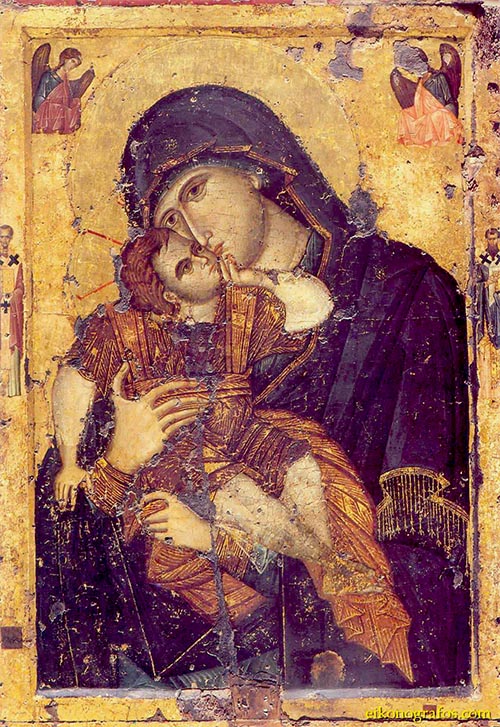 The Playing Child
The Playing Child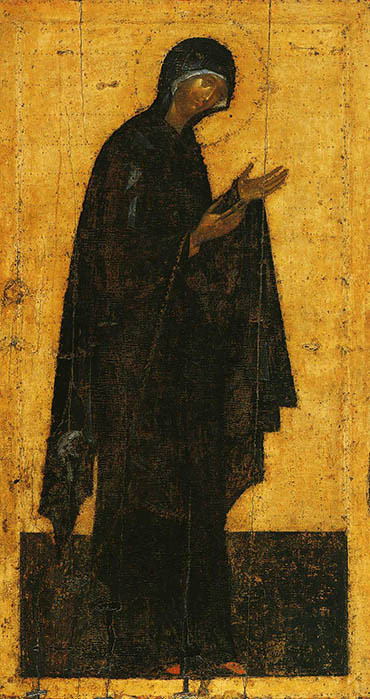 Andrei Rublev Theotokos
Andrei Rublev Theotokos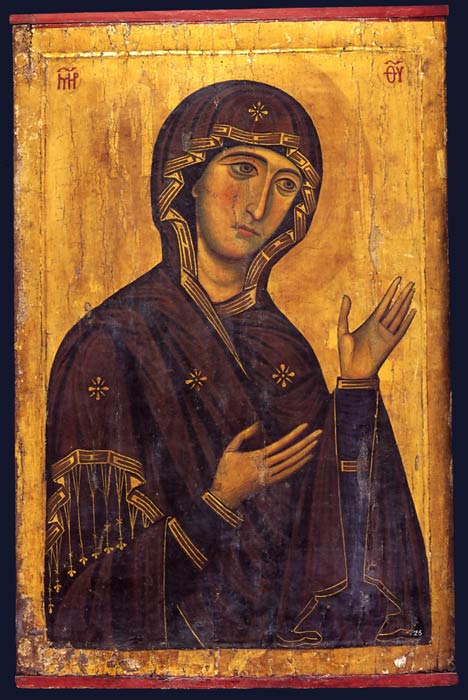 Sinai Theotokos
Sinai Theotokos Hodegetria
Hodegetria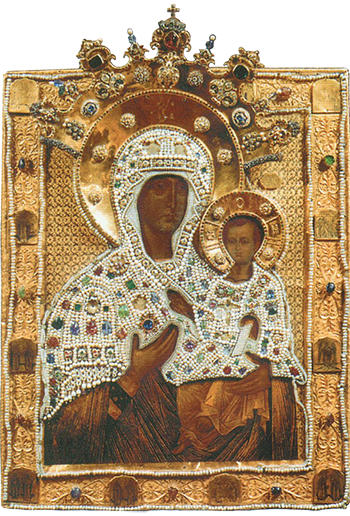 Hodegetria
Hodegetria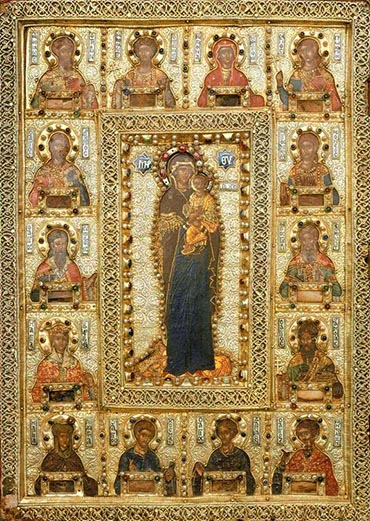 Palaiologian Reliquary
Palaiologian Reliquary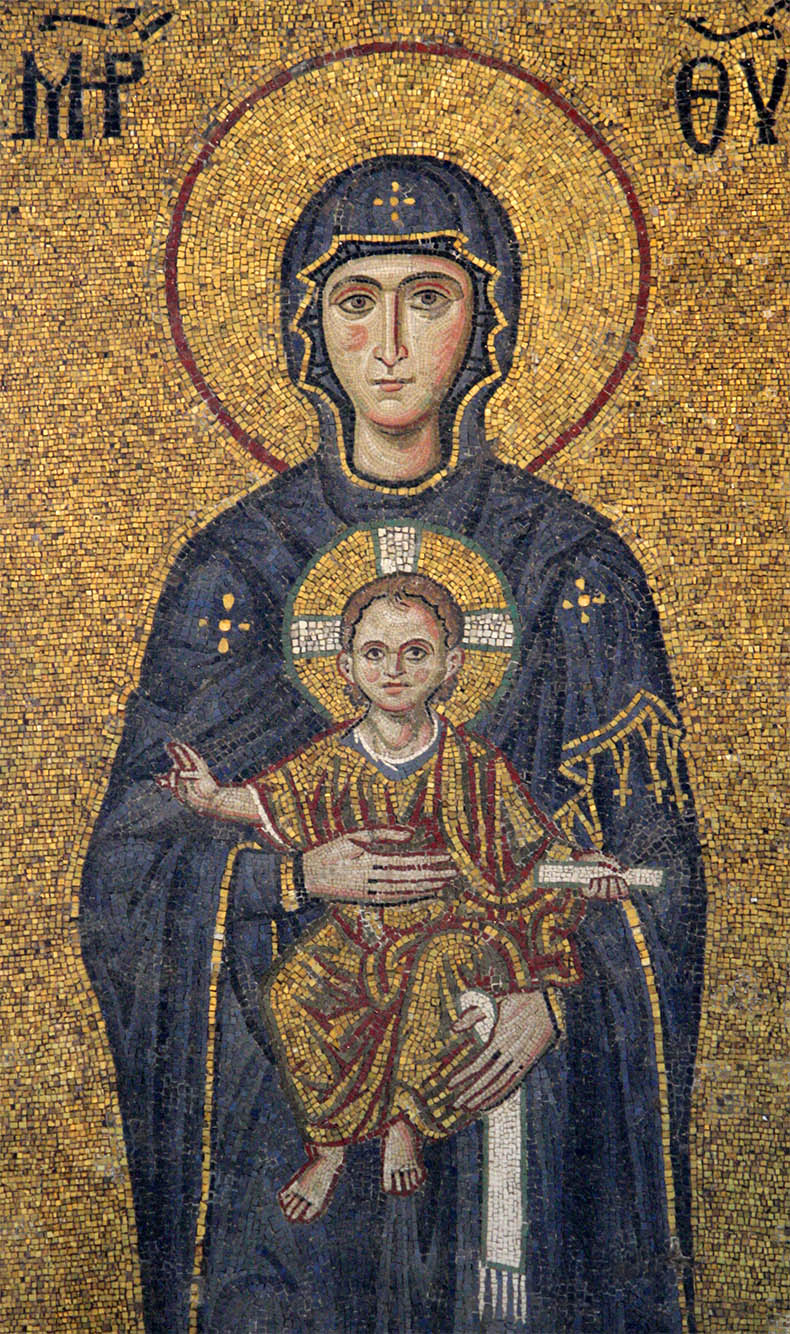 Hagia Sophia Theotokos
Hagia Sophia Theotokos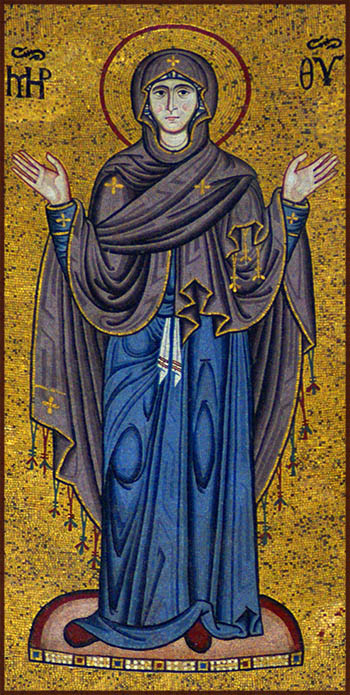 Cefalu Theotokos
Cefalu Theotokos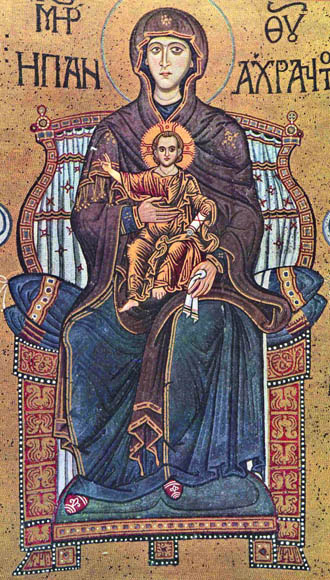 Monreale Theotokos
Monreale Theotokos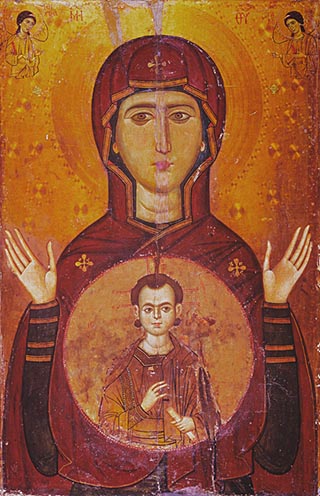 Theotokos Blachernitissa
Theotokos Blachernitissa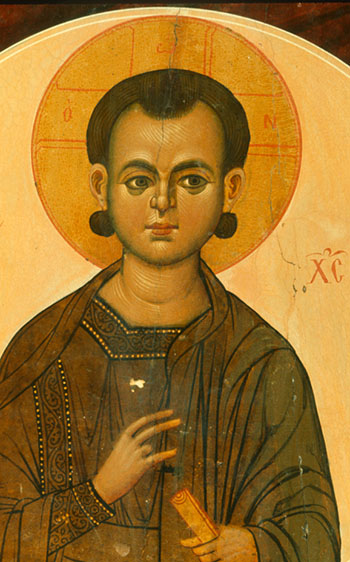 Here is a close-up showing Christ. He is always shown having high forehead like this. Here we can also see two curls, one on each side of his neck. Compare this to the head of Christ in the Mellon icon and you can see how the restoration botched the shape of the head and the hair.
Here is a close-up showing Christ. He is always shown having high forehead like this. Here we can also see two curls, one on each side of his neck. Compare this to the head of Christ in the Mellon icon and you can see how the restoration botched the shape of the head and the hair.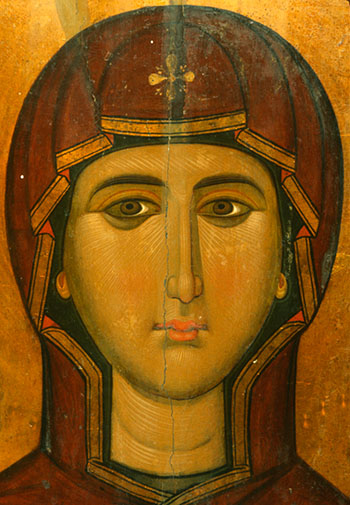
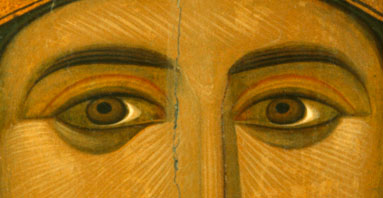 The three previous pictures were taken before the icon was restored, removing later touch-ups. This icon is really large, the highlights have been applied in many broad strokes.
The three previous pictures were taken before the icon was restored, removing later touch-ups. This icon is really large, the highlights have been applied in many broad strokes.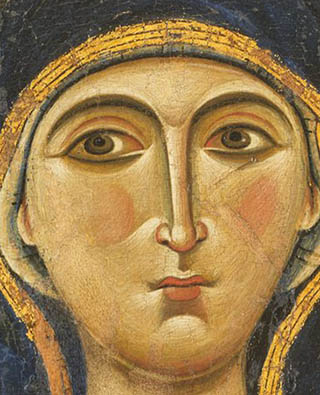

 After the end of iconoclasm icons were allowed back into Hagia Sophia. At first they were placed on the walls at eye level so people could venerate them. These icons were in lots of different sizes from small to over life-sized. The aisles of the church were lined with shrines with icons and candle stands in front of them. The circuit of Hagia Sophia - this circle of images covered in silver, gold and gemstones - was one of the greatest masses of treasures in the world at the time. There was a period of time before mosaic images were put on the walls. One reason was their was hesitation that iconoclasm might return and slao the scale of this monumental image of the Theotokos had not been attempted for a very long time. There must have been a considerable period to planning that went into creating it. This image of Mary with the Christ Child on her lap must have been based on an illustration in a book or an existing icon - both small prototypes. The artists must have used some system to make the drawing in the apse, it is generally believed that they used circles to establish the proportions and then did a drawing followed by full-scale fresco that became the pattern for the mosaicists. The mosaic would have been put up using a wood scaffold - just like the one you see below. The Theotokos is youthful and very beautiful. She always wears one or two of three colors - imperial purple, dark violet and royal blue. Mary is always shown wearing a dress and a mantle called a maphorion. One of the chief relics if the city was the virgin's maphorion, which was kept in the Soros at the
After the end of iconoclasm icons were allowed back into Hagia Sophia. At first they were placed on the walls at eye level so people could venerate them. These icons were in lots of different sizes from small to over life-sized. The aisles of the church were lined with shrines with icons and candle stands in front of them. The circuit of Hagia Sophia - this circle of images covered in silver, gold and gemstones - was one of the greatest masses of treasures in the world at the time. There was a period of time before mosaic images were put on the walls. One reason was their was hesitation that iconoclasm might return and slao the scale of this monumental image of the Theotokos had not been attempted for a very long time. There must have been a considerable period to planning that went into creating it. This image of Mary with the Christ Child on her lap must have been based on an illustration in a book or an existing icon - both small prototypes. The artists must have used some system to make the drawing in the apse, it is generally believed that they used circles to establish the proportions and then did a drawing followed by full-scale fresco that became the pattern for the mosaicists. The mosaic would have been put up using a wood scaffold - just like the one you see below. The Theotokos is youthful and very beautiful. She always wears one or two of three colors - imperial purple, dark violet and royal blue. Mary is always shown wearing a dress and a mantle called a maphorion. One of the chief relics if the city was the virgin's maphorion, which was kept in the Soros at the  In the 1750's Ottoman power was under threat and the survival of the empire was under threat from both the Catholic Hapsburgs and the Orthodox Romanovs. In the face of this threat the Ottoman state had two options - to reorganize the military, liberalize the system and promote diversity among the many nationalities and religions that made up its population - or turn more authoritarian and enforce a more-Muslim identity on everyone. The Ottoman state lost its faith in the idea of a multi-national gathering of peoples under the Ottoman dynasty. The Ottomans were now facing a deadly line of Christian armies that were moving south. It was a religious war - a war between Islam and Christianity - that had reversed itself. Russia and Austria were on the rise and the Ottomans were on the defensive. They were entering a period of great uncertainty and loss of confidence. The most urgent task that faced them was the reorganization of army. If the army could not stop the Christian armies they were finished. Next they turned their attention to militarizing Islam within the empire. They hoped that the old Ghazi spirit of Muslim warriors who would fight the Christians with the religious fervor of the 1300s and 1400s.
In the 1750's Ottoman power was under threat and the survival of the empire was under threat from both the Catholic Hapsburgs and the Orthodox Romanovs. In the face of this threat the Ottoman state had two options - to reorganize the military, liberalize the system and promote diversity among the many nationalities and religions that made up its population - or turn more authoritarian and enforce a more-Muslim identity on everyone. The Ottoman state lost its faith in the idea of a multi-national gathering of peoples under the Ottoman dynasty. The Ottomans were now facing a deadly line of Christian armies that were moving south. It was a religious war - a war between Islam and Christianity - that had reversed itself. Russia and Austria were on the rise and the Ottomans were on the defensive. They were entering a period of great uncertainty and loss of confidence. The most urgent task that faced them was the reorganization of army. If the army could not stop the Christian armies they were finished. Next they turned their attention to militarizing Islam within the empire. They hoped that the old Ghazi spirit of Muslim warriors who would fight the Christians with the religious fervor of the 1300s and 1400s. And there were fires - there were more 100 great fires in the 1700's. Great fires in Constantinople are always a sign of over-population and unhealthy living conditions. In 1712 the area of the Great Palace burned. In 1729 there was a great fire that burned an eighth of the city, including the Byzantine palace, Tekfur Saray. Sometimes there were multiple fires in one year, in 1746 there where 4 big blazes, that burnt thousands of houses. It must have felt like the city was constantly burning. One can imagine the flames and the smoke being seen continuously all over the city. In 1756 a fire in the Cibali district damaged 70 Turkish baths, 580 mills and bakes shops, 10 inns, 200 mosques and small mosques, 1000 shops and 800 dwellings.
And there were fires - there were more 100 great fires in the 1700's. Great fires in Constantinople are always a sign of over-population and unhealthy living conditions. In 1712 the area of the Great Palace burned. In 1729 there was a great fire that burned an eighth of the city, including the Byzantine palace, Tekfur Saray. Sometimes there were multiple fires in one year, in 1746 there where 4 big blazes, that burnt thousands of houses. It must have felt like the city was constantly burning. One can imagine the flames and the smoke being seen continuously all over the city. In 1756 a fire in the Cibali district damaged 70 Turkish baths, 580 mills and bakes shops, 10 inns, 200 mosques and small mosques, 1000 shops and 800 dwellings.




 The Virgin's Face and Neck
The Virgin's Face and Neck The Virgin's Feet
The Virgin's Feet




 TEXTUAL EVIDENCE
TEXTUAL EVIDENCE



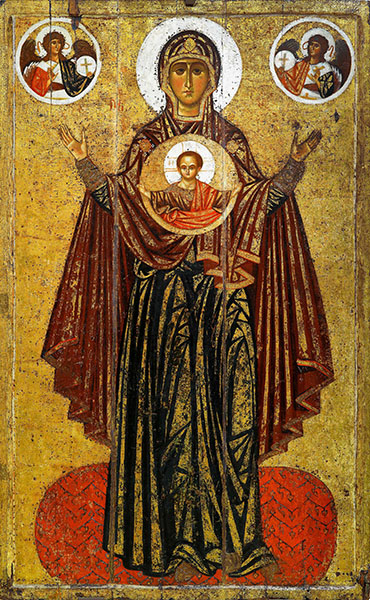
 click here for icons of christ
click here for icons of christ click here for icons of the theotokos
click here for icons of the theotokos click here for icons of angels
click here for icons of angels click here for icons of saints
click here for icons of saints








